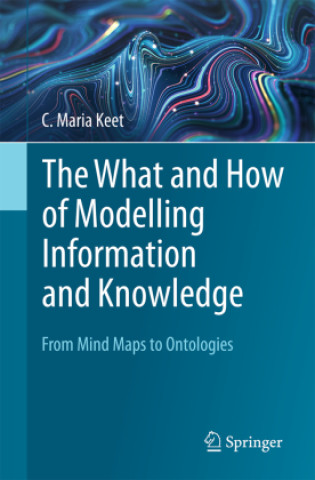
Code: 43703957
The What and How of Modelling Information and Knowledge
by C. Maria Keet
The main aim of this book is to introduce a group of models and modelling of information and knowledge comprehensibly. Such models and the processes for how to create them help to improve the skills to analyse and structure though ... more
- Language:
 English
English - Binding: Paperback
- Number of pages: 165
Publisher: Springer, Berlin, 2023
- More about this

89.87 €

Low in stock at our supplier
Shipping in 10 - 15 days
Potřebujete více kusů?Máte-li zájem o více kusů, prověřte, prosím, nejprve dostupnost titulu na naši zákaznické podpoře.
Add to wishlist
You might also like
-

Your Mind Is Your Best Weapon: Write Your Inspirational Quotes and Motivational Ideas. That's What Will Make Your Mind Your Best Weapon. Never Forget
10.88 € -

The Main Enemy
10.06 € -3 % -

Wizardology
25.36 € -19 % -

Bright Young Women
13.75 € -23 % -

The Japanese Art of the Cocktail
24.75 € -21 % -

Egon Schiele
131.47 € -

The Dark Queens: The Bloody Rivalry That Forged the Medieval World
19.81 € -8 % -

Haunting Adeline
30.81 € -

Prague Stories
15.81 € -9 % -

Hatmakers
9.65 € -13 % -

Dark Souls Vol. 1: The Breath of Andolus (Graphic Novel)
18.79 € -13 % -

87 Days
17.66 € -

Wicked King
8.93 € -21 % -

The Nightmare Before Christmas Tarot Deck and Guidebook
20.74 € -21 % -

Treasure Hunter
24.13 € -

Frenemies
20.23 € -

Glasshouse of Stars
10.47 € -14 % -

Periodization of Strength Training for Sports
36.04 € -10 % -

Laws of Human Nature
30.50 € -14 % -

No Geography
44.98 € -6 % -

Tools of Argument
15.81 € -

There Is No Devil
18.58 € -4 % -

Demon's Guide to Wooing a Witch
10.06 € -23 % -

Insomniacs After School, Vol. 2
11.19 € -23 % -

Deník - Kohnová Věra
9.34 € -7 % -

Creating Capabilities
21.87 € -6 % -

Enemies
17.86 € -17 % -

Hyperbole and a Half
12.93 € -24 % -

Starship Troopers
10.98 € -24 % -

Where All Good Flappers Go: Essential Stories of the Jazz Age
13.34 € -23 % -

Society of the Crossed Keys
11.19 € -23 % -

Where Reasons End
11.19 € -23 % -

Incorrigible Children of Ashton Place: Book V
8.41 € -20 % -

Batgirl Vol. 1: Batgirl of Burnside (The New 52)
13.45 € -18 % -

Fullmetal Alchemist (3-in-1 Edition), Vol. 1
12.32 € -23 % -

Stoicism
225.87 € -

The Complete Maus
30.60 € -16 % -

Wes Anderson Collection: The Grand Budapest Hotel
31.22 € -16 % -

Cocrea tu mundo
15.09 € -

Betónová blondína
11.60 € -12 % -

Prasátko Peppa - škola a školní autobus hrací set
82.17 € -

Bonhoeffer
22.07 € -16 % -

Mezi námi piloty
9.65 € -24 % -

Kam odešlo mé hovínko?
10.16 € -16 % -

Pracovní sešit Prima A1
8.41 € -

Azurové nevěry
10.06 € -14 % -

Gra Mam na oku mini
5.02 € -1 % -

Geografia Podręcznik 3 Liceum I Technikum Zakres Rozszerzony
19.61 € -

Dějiny zemí Koruny české v datech I. díl
21.66 € -19 % -

Lucia
17.86 € -19 % -

Wie Sie einen Atomangriff überleben
22.38 € -4 % -

Dokud jsme naživu
2.25 € -6 % -

Kroužkový blok ROVNOVÁHA A6, linka, 50 listů
2.76 € -13 % -

Bez Boha na světě
6.67 € -13 % -

Obnovíš tvář země
9.23 € -15 % -

Prestreté
7.80 € -23 % -

Cesta ke zdraví
6.46 € -16 % -

Goethe
35.02 € -

Miniatury Matematyczne 45
5.74 € -6 % -

Hrabina Cosel
10.98 € -

Dzieje Polski Tom 1
19.61 € -11 % -

Meyers Universalatlas
20.53 € -

Ekonomie a ekonomika
34.40 € -

Kámen jsem dostal darem
9.95 € -17 % -

Příběhy šampionů pro budoucí sportovní hvězdy
8.72 € -28 % -

Koperta A4 biała zatrzask Grand
2.35 € -

Nelly Rapp i czarownicy z Wittenbergi
7.49 € -14 % -

Handwritten (Revisited)
15.40 € -

Zvířátka v pohybu Farma
5.84 € -27 % -

Vitajte v KĽDR
8.41 € -22 %
Give this book as a present today
- Order book and choose Gift Order.
- We will send you book gift voucher at once. You can give it out to anyone.
- Book will be send to donee, nothing more to care about.
More about The What and How of Modelling Information and Knowledge
You get 221 loyalty points
 Book synopsis
Book synopsis
The main aim of this book is to introduce a group of models and modelling of information and knowledge comprehensibly. Such models and the processes for how to create them help to improve the skills to analyse and structure thoughts and ideas, to become more precise, to gain a deeper understanding of the matter being modelled, and to assist with specific tasks where modelling helps, such as reading comprehension and summarisation of text. The book draws ideas and transferrable approaches from the plethora of types of models and the methods, techniques, tools, procedures, and methodologies to create them in computer science.This book covers five principal declarative modelling approaches to model information and knowledge for different, yet related, purposes. It starts with entry-level mind mapping, to proceed to biological models and diagrams, onward to conceptual data models in software development, and from there to ontologies in artificial intelligence and all the way to ontology in philosophy. Each successive chapter about a type of model solves limitations of the preceding one and turns up the analytical skills a notch. These what-and-how for each type of model is followed by an integrative chapter that ties them together, comparing their strengths and key characteristics, ethics in modelling, and how to design a modelling language. In so doing, we'll address key questions such as: what type of models are there? How do you build one? What can you do with a model? Which type of model is best for what purpose? Why do all that modelling?The intended audience for this book is professionals, students, and academics in disciplines where systematic information modelling and knowledge representation is much less common than in computing, such as in commerce, biology, law, and humanities. And if a computer science student or a software developer needs a quick refresher on conceptual data models or a short solid overview of ontologies, then this book will serve them well.
 Book details
Book details
89.87 €
- Full title: The What and How of Modelling Information and Knowledge
- Subtitle: From Mind Maps to Ontologies
- Author: C. Maria Keet
- Language:
 English
English - Binding: Paperback
- Number of pages: 165
- EAN: 9783031396946
- ID: 43703957
- Publisher: Springer, Berlin
- Dimensions: 235 × 155 mm
- Date of publishing: 25. December 2023
Trending among others
-

Berserk Deluxe Volume 1
48.58 € -5 % -

Berserk Deluxe Volume 2
52.48 € -

Berserk Deluxe Volume 3
51.86 € -

Atomic Habits
16.01 € -15 % -

Cry Baby Coloring Book
11.49 € -

House of Leaves
23.51 € -22 % -

Powerless
11.91 € -9 % -

The Official Stardew Valley Cookbook
26.08 € -9 % -

Harry Potter and the Prisoner of Azkaban (Minalima Edition)
41.80 € -

Chainsaw Man, Vol. 15
13.14 € -3 % -

JUJUTSU KAISEN V22
13.24 € -2 % -

Hunting Adeline
31.94 € -

Iron Flame
16.53 € -24 % -

White Nights
3.58 € -24 % -

Gravity Falls Journal 3
18.38 € -16 % -

Berserk Deluxe Volume 5
52.48 € -

Berserk Deluxe Volume 4
48.37 € -5 % -

Bungo Stray Dogs, Vol. 8 (light novel)
16.63 € -

Twisted Love
9.75 € -19 % -

Surrounded by Idiots
10.78 € -11 % -

The 48 Laws of Power
26.18 € -4 % -

Berserk Deluxe Volume 6
51.35 € -

Dungeons & Dragons Essentials Kit (D&d Boxed Set)
26.70 € -

Fourth Wing
10.26 € -15 % -

Twisted Lies
9.85 € -24 % -

Twisted Games
9.85 € -24 % -

Dune Messiah
9.03 € -21 % -

A Little Life
17.45 € -

No Longer Human
13.45 € -7 % -

Court of Thorns and Roses Paperback Box Set (5 books)
59.05 € -6 % -

Heaven Official's Blessing: Tian Guan Ci Fu (Novel) Vol. 2
22.18 € -

The Husky and His White Cat Shizun: Erha He Ta de Bai Mao Shizun (Novel) Vol. 5
20.23 € -3 % -

CHAINSAW MAN V14
11.49 € -12 % -

Court of Thorns and Roses
9.34 € -20 % -

Court of Mist and Fury
9.44 € -19 % -

Harry Potter and the Chamber of Secrets: MinaLima Edition
30.09 € -24 % -

Heaven Official's Blessing: Tian Guan Ci Fu (Novel) Vol. 1
21.66 € -

Heaven Official's Blessing: Tian Guan Ci Fu Vol. 4
19.92 € -5 % -

King of Sloth
10.67 € -18 % -

Berserk Deluxe Volume 7
52.17 € -

Dune
9.75 € -19 % -

Raising Mentally Strong Kids: How to Combine the Power of Neuroscience with Love and Logic to Grow Confident, Kind, Responsible, and Resilient Child
29.98 € -

Icebreaker
9.13 € -24 % -

48 Laws Of Power
18.17 € -10 % -

Vagabond (VIZBIG Edition), Vol. 1
24.54 € -6 % -

Berserk Deluxe Volume 10
58.75 € -

Berserk Deluxe Volume 11
49.40 € -3 % -

Twisted Series 4-Book Boxed Set
47.55 € -6 %
Collection points Bratislava a 2642 dalších
Copyright ©2008-24 najlacnejsie-knihy.sk All rights reservedPrivacyCookies


 15549 collection points
15549 collection points Delivery 2.99 €
Delivery 2.99 € 02/210 210 99 (8-15.30h)
02/210 210 99 (8-15.30h)